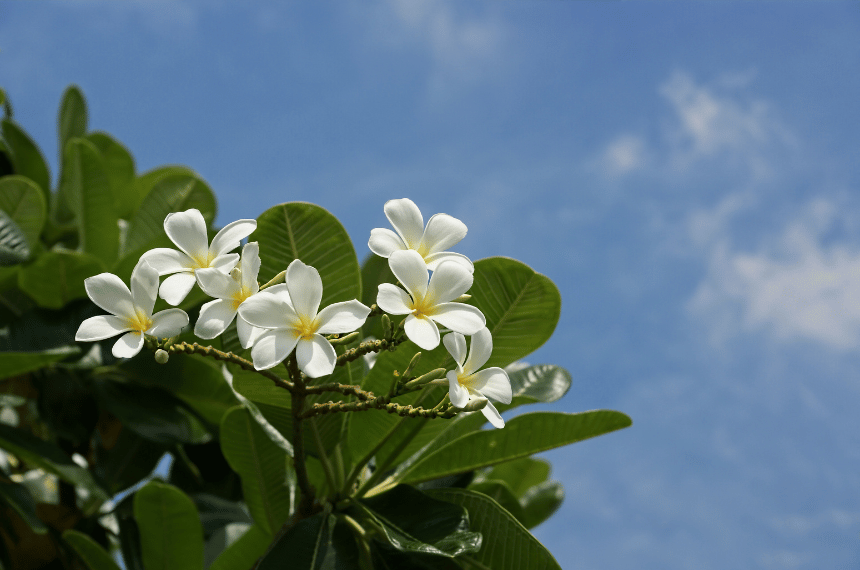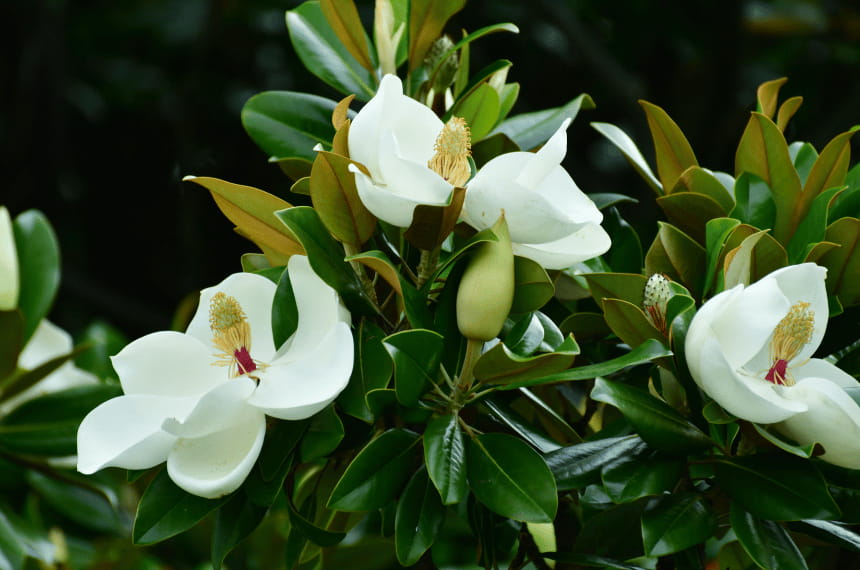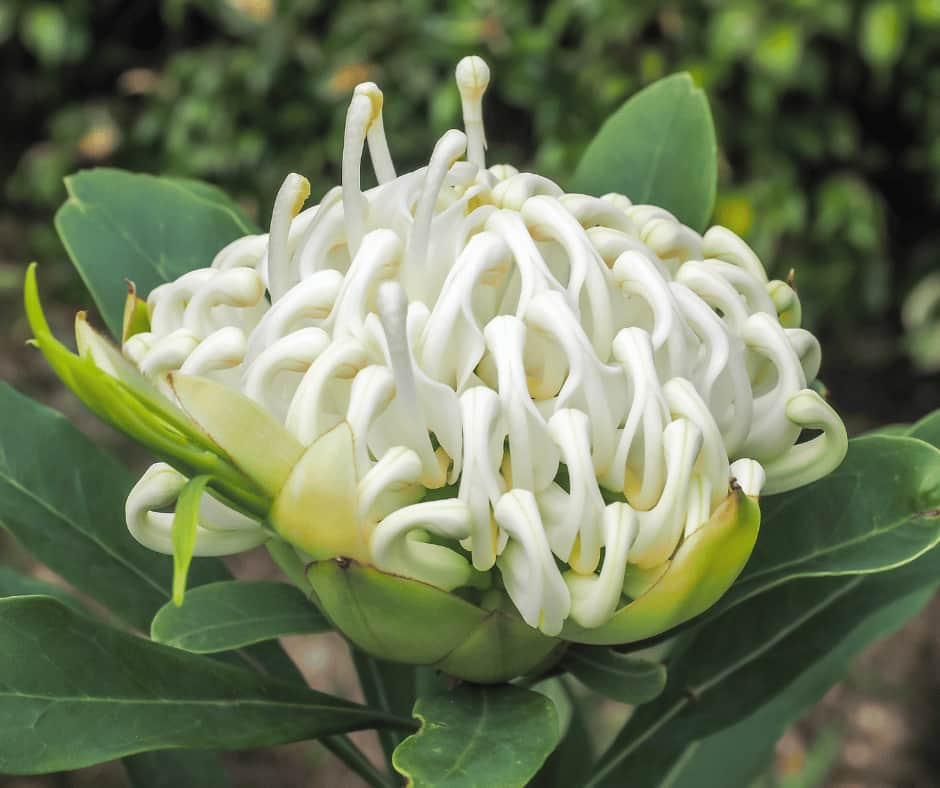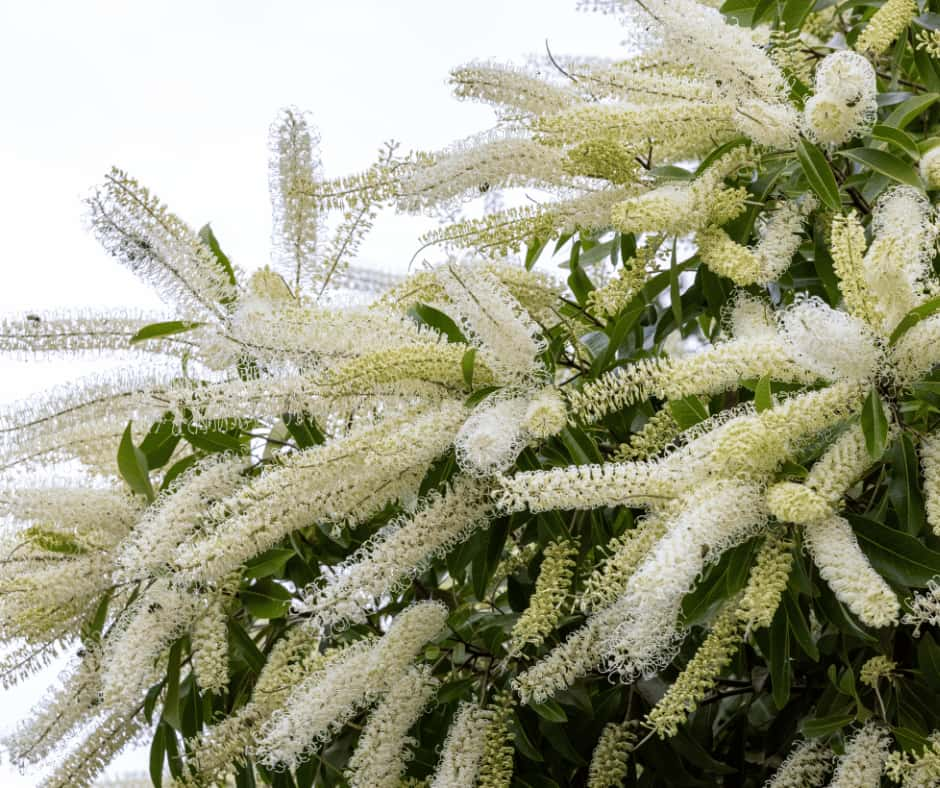White flowering trees hold a special place in the diverse tapestry of Australian gardens, enchanting us with their serene beauty and symbolic depth. These trees, celebrated for their pristine blossoms, are more than just a visual treat; they embody purity, peace, and timeless elegance.
These white blooms have gained immense popularity across Australia, from the bustling urban landscapes to the tranquil suburban backyards. Their versatility is unmatched, effortlessly adapting to various garden styles, whether a contemporary minimalist design or a more traditional, lush garden setting.
As we delve into the world of these captivating trees, let’s explore how they can transform your garden into a haven of tranquillity and beauty.
White flowering tree identification

Identifying white flowering trees in our Australian landscapes hinges on observing a few key characteristics: leaf patterns, flower shapes, and blooming seasons. Let’s unravel these identifiers to help you recognize these beauties in your garden or during your next nature walk.
- Leaf patterns: Often, the journey to identification begins with the leaves. Look for unique features – are they broad or narrow, glossy or matte? Some trees, like the Magnolia Grandiflora, boast large, glossy leaves. In contrast, others like the Star Jasmine feature smaller, more delicate foliage.
- Flower shapes: The shape of the flowers is a telltale sign. The iconic Frangipani, for instance, flaunts its distinctive, propeller-shaped blossoms, whereas the Gardenia presents lush, rosette-like flowers. Each tree’s flowers have their signature shape, from the trumpet-like blooms of the White Jacaranda to the intricate, star-shaped flowers of the Mock Orange.
- Blooming seasons: Timing is everything. While the Ivory Curl Tree bursts into bloom with its creamy cascades in summer, the White Waratah showcases its floral splendour in spring. Recognising when these trees flower not only aids in identification but also helps in planning your garden’s year-round appeal.
By familiarising ourselves with these aspects, we can better appreciate the diversity and beauty of white flowering trees in our Australian environment.
Benefits of white flowering trees in landscaping
Incorporating white flowering trees into landscaping brings a multitude of benefits, both ecological and aesthetic.
Here’s how these trees enrich our gardens and ecosystems:
- Enhancing biodiversity: White flowering trees are more than just a visual delight; they’re vital for biodiversity. Their blossoms attract pollinators, including bees, butterflies, and birds, fostering a thriving garden ecosystem. For instance, the nectar-rich blooms of the Star Jasmine are a haven for bees, while the large flowers of Magnolia Grandiflora provide a nutritious stopover for local bird species.
- Creating a serene ambience: There’s an undeniable tranquillity that white flowers bring to a garden. Their pristine appearance evokes a sense of calm and purity, transforming outdoor spaces into serene retreats. The gentle sway of Frangipani flowers in the breeze or the soft glow of Gardenias under moonlight can turn any garden into a peaceful sanctuary.
- Temperature regulation: Surprisingly, the colour white plays a role in temperature control. White flowers reflect sunlight, helping to keep the surrounding area cooler, a welcome feature in the warmer Australian climates.
- Versatile design element: White flowering trees are incredibly versatile in landscape design. They can serve as stunning focal points, harmonise with various colour schemes, or create striking contrasts against darker foliage, offering endless design possibilities.
By embracing these trees, we enhance the aesthetic appeal of our gardens and contribute positively to the local environment.
Trees with white flowers in Australia
In the lush greenery of Australia, a select group of trees stand out, adorned with the purest white flowers. These trees not only enhance the beauty of our landscapes but also bring ecological benefits. Here’s a quick snapshot of some of our most beloved white flowering trees gracing Australian gardens:
- Frangipani (Plumeria)
- Star Jasmine (Trachelospermum jasminoides)
- Mock Orange (Philadelphus)
- Gardenia (Gardenia augusta)
- Magnolia Grandiflora
- White Jacaranda (Jacaranda mimosifolia ‘Alba’)
- White Waratah (Telopea speciosissima ‘Wirrimbirra White’)
- Ivory Curl Tree (Buckinghamia celsissima)
Each of these trees brings its unique charm and benefits to our gardens. Let’s dive deeper into what makes each of these white flowering trees special and how they can transform your outdoor space.
Small trees with white flowers
1. Frangipani (Plumeria)

The Frangipani, known botanically as Plumeria, is a quintessential small tree that brings a tropical flair to Australian gardens. Its botanical characteristics are as enchanting as they are distinctive. The tree typically grows to a height of 5-6 metres, making it an ideal choice for smaller gardens or as a striking container plant.
- Botanical characteristics: Frangipani is celebrated for its lush, fragrant flowers, which bloom in various colours, though the white variety is a classic favourite. These flowers are composed of five waxy petals, radiating a soothing fragrance that intensifies at night. The tree’s branches are thick and fleshy, with a sparse spread of large, leathery leaves clustered near the tips.
- Ideal growing conditions: Thriving in full sun and well-drained soil, Frangipani is well-suited to Australia’s warmer climates. It’s remarkably drought-tolerant once established, though it appreciates regular watering during the growing season.
- Common uses in gardens: Frangipani is often used as a feature tree in Australian gardens due to its striking appearance and delightful scent. It’s perfect for creating a tropical oasis in backyard gardens, courtyards, or even as a welcoming plant near entrances.
- Best suited gardens: Gardens that would most benefit from a Frangipani are those looking to create a tropical or beach-like ambience. Its low height and broad canopy make it an excellent choice for providing shade in small to medium-sized gardens or as part of a mixed border in larger landscapes. Additionally, its drought resistance makes it a suitable option for water-wise gardens.
2. Star Jasmine (Trachelospermum jasminoides)

Star Jasmine, or Trachelospermum jasminoides, is a versatile and enchanting plant often cultivated as a small tree in Australian gardens. Its botanical charm and adaptability make it a favourite among garden enthusiasts.
- Botanical characteristics: Star Jasmine is renowned for its glossy, dark green leaves and highly fragrant, star-shaped white flowers that bloom profusely in spring and early summer. The plant can grow up to 2 metres tall when supported and trained as a tree. Its twining stems and dense foliage create an elegant, bushy appearance, making it an attractive addition to any garden.
- Ideal growing conditions: This plant thrives in various conditions but prefers well-drained soil and a position in full sun to partial shade. While it tolerates a range of soil types, Star Jasmine performs best in fertile, loamy soil. Regular watering, especially during dry periods, encourages robust growth and flowering.
- Common uses in gardens: Star Jasmine is often used as a decorative feature in Australian gardens due to its beautiful foliage and fragrant flowers. It’s ideal for planting near patios, terraces, or entrances where its delightful scent can be fully appreciated. Additionally, its training and pruning ability makes it perfect for use as a small, ornamental tree or a living screen.
- Best suited gardens: Star Jasmine is particularly well-suited for urban gardens with limited space. Its versatility allows it to be used in various garden styles, from formal to cottage gardens. It’s also an excellent choice for gardens requiring low-maintenance plants that offer year-round interest. For those looking to attract wildlife, its flowers are a magnet for pollinators, adding an ecological benefit to its ornamental value.
3. Mock Orange (Philadelphus)

Mock Orange, scientifically known as Philadelphus, is a delightful small tree cherished in Australian gardens for its fragrant, showy white flowers.
- Botanical characteristics: Mock Orange is distinguished by its profusion of white, sweetly scented flowers that resemble orange blossoms, hence its name. These blooms, appearing in late spring to early summer, are set against a backdrop of dark green, oval-shaped leaves. The tree typically reaches 1 to 3 metres, forming a rounded and bushy silhouette.
- Ideal growing conditions: This plant flourishes in well-drained, fertile soil and prefers a sunny to partly shaded location. While adaptable to various soil types, Mock Orange appreciates a moist, humus-rich environment. Regular watering, particularly during dry spells, and annual pruning after flowering help maintain its shape and promote vigorous growth.
- Common uses in gardens: In Australian gardens, Mock Orange is often utilised as a feature plant or as part of a mixed border due to its attractive foliage and stunning floral display. Its compact size makes it suitable for smaller gardens, and its fragrant flowers are ideal for planting near outdoor living areas where their scent can be enjoyed.
- Best suited gardens: Gardens that would most benefit from Mock Orange are designed for sensory experiences, where fragrance and visual appeal are paramount. It’s an excellent choice for cottage gardens, sensory gardens, and urban spaces where its compact growth habit is particularly advantageous. Additionally, Mock Orange can be a great addition to wildlife-friendly gardens, attracting bees and other pollinators.
4. Gardenia (Gardenia augusta)

Gardenia augusta, commonly known as Gardenia, is a beloved small tree in Australian gardens, revered for its exquisite flowers and sweet fragrance. The best part about Gardenia’s is its unique ability to flower all year round in Australia!
- Botanical characteristics: Gardenias are renowned for their creamy white, intensely fragrant flowers, which bloom against glossy, dark green leaves. Often associated with purity and peace, the flowers typically appear in late spring and summer. This evergreen shrub can grow to a height of 1 to 2 metres, forming a dense, rounded shape.
- Ideal growing conditions: Gardenias thrive in warm, humid climates and prefer well-drained, acidic soil rich in organic matter. They require a position in partial shade, as too much direct sunlight can scorch the leaves, while too little can hinder flowering. Regular watering, especially during dry periods, and a consistent feeding schedule with an acid-formulating fertiliser are crucial for their health and blooming.
- Common uses in gardens: Gardenias are often used as feature plants in Australian gardens due to their stunning flowers and alluring scent. They are perfect for planting near windows or outdoor seating areas where their fragrance can be enjoyed. Their lush foliage and compact growth habit make them ideal for flowering hedges, borders, or container plants in patio gardens.
- Best suited gardens: Gardenias are particularly well-suited for formal and cottage gardens, where their elegant appearance and fragrance add a touch of luxury. They are also great for small urban gardens or courtyards with premium space. For gardeners looking to create a relaxing, sensory-rich environment, Gardenias are an excellent addition, providing both visual beauty and a delightful aroma.
Large trees with white flowers
5. Magnolia Grandiflora

Magnolia Grandiflora, often called the Southern Magnolia, is a majestic large tree that graces many Australian landscapes with its grandeur and elegance.
- Size and growth habit: This evergreen tree is known for its impressive stature, typically reaching heights of 15 to 20 metres, with some specimens growing even taller. It has a pyramidal to rounded canopy, offering dense shade beneath its wide-spreading branches.
- Flowering habits: The Southern Magnolia is celebrated for its large, creamy white flowers that bloom from late spring through summer. Each flower, measuring up to 30 cm in diameter, emits a sweet, lemony fragrance. The blossoms are not only visually stunning but also attract various pollinators, adding to the ecological value of the tree.
- Suitability for landscape settings: Magnolia Grandiflora is a versatile tree that fits well in various landscape settings. Its grand size makes it an ideal choice for large gardens and parks and as a street tree in spacious avenues. It serves as a magnificent focal point or a natural privacy screen in residential settings. The tree’s evergreen nature ensures year-round interest, making it a valuable addition to any landscape design.
- Ideal growing conditions: This magnolia variety prefers well-drained, slightly acidic soil and a sunny to partly shaded location. While it is relatively drought-tolerant once established, regular watering during its formative years encourages healthy growth. The tree is also known for its resilience to pests and diseases, making it a low-maintenance option for gardeners.
Magnolia Grandiflora, with its stately appearance and captivating flowers, is a splendid choice for those looking to add a touch of elegance and a sense of grandeur to their landscapes.
6. White Jacaranda (Jacaranda mimosifolia ‘Alba’)

The White Jacaranda, a variant of the classic Jacaranda mimosifolia, is a large, captivating tree known for its unique and ethereal beauty in Australian landscapes.
- Size and growth habit: The White Jacaranda is a fast-growing tree reaching up to 15 metres, creating a broad and open canopy. Its elegant, fern-like foliage provides dappled shade, making it a favourite for public and private gardens.
- Flowering habits: Unlike its more common purple counterpart, the White Jacaranda boasts clusters of delicate white flowers. These blossoms create a stunning contrast against the tree’s green foliage and typically appear in late spring to early summer. The floral display is visually striking and attracts a variety of pollinators, contributing to the local ecosystem.
- Suitability for landscape settings: This tree is particularly well-suited for large gardens, avenues, and park settings where its full size and beauty can be appreciated. It’s an excellent choice for adding a focal point in landscape designs. It is often used in urban settings for its shade and ornamental value. The White Jacaranda can also be planted in rows along streets or driveways, creating a breathtaking floral tunnel effect when in bloom.
- Ideal growing conditions: Thriving in well-drained soil and full sun, the White Jacaranda is relatively drought-tolerant once established. It prefers a warm climate and is suited to many regions across Australia. Regular pruning can help maintain its shape and encourage more prolific blooming.
The White Jacaranda is a stunning and unique addition to any landscape, offering a different take on the classic Jacaranda tree with its spectacular white blooms and graceful foliage.
7. White Waratah (Telopea speciosissima ‘Wirrimbirra White’)

The White Waratah, a rare and striking variant of the iconic Australian Waratah, is a testament to the unique beauty of the Australian flora.
- Size and growth habit: The White Waratah is a large shrub or small tree, typically reaching heights of 2 to 4 metres. It features a compact and bushy growth habit, making it a versatile addition to various garden settings. The foliage is dark and leathery, providing a perfect backdrop for its flowers.
- Flowering habits: This plant is renowned for its spectacular, large, white flowers that bloom in spring. The blooms are a unique feature in the garden, with each flower comprising numerous small florets that form a striking and intricate display. These flowers add aesthetic value and attract birds and pollinators, enhancing the garden’s biodiversity.
- Suitability for landscape settings: The White Waratah is an excellent choice for native and bush gardens, whose natural beauty complements the Australian landscape. It’s also well-suited as a feature plant in mixed borders or a stunning standalone specimen in smaller gardens. It can bring a touch of the Australian bush to the cityscape in urban settings.
- Ideal growing conditions: Preferring well-drained, slightly acidic soil, the White Waratah thrives in a sunny, partly shaded position. It benefits from regular watering, especially during dry periods, and responds well to pruning after flowering, which helps maintain its shape and promotes more prolific blooming in the following season.
In short, the White Waratah is a magnificent and unique plant that brings Australian native beauty to any garden, offering a splendid display of white blooms that will captivate and inspire.
8. Ivory Curl Tree (Buckinghamia celsissima)

The Ivory Curl Tree, known botanically as Buckingham cellissima, is a spectacular large tree native to the rainforests of Queensland, Australia. It’s celebrated for its stunning floral displays and lush foliage.
- Size and growth habit: The Ivory Curl Tree can reach impressive heights of 15 to 30 metres in its natural rainforest habitat, but it’s often smaller in garden settings. It has a pyramidal to oval canopy that provides dense shade. The tree’s evergreen nature ensures it remains a vibrant feature throughout the year.
- Flowering habits: This tree is renowned for its profuse, ivory-white, curl-like flowers that appear in long, spectacular racemes at the ends of the branches. These blossoms, which typically emerge in late summer and continue into autumn, are not only a visual delight but also attract a variety of nectar-feeding birds and insects, adding to the ecological value of the tree.
- Suitability for landscape settings: The Ivory Curl Tree is ideally suited for large gardens and parks and as a street tree in spacious avenues. Its grand size and stunning floral display make it an excellent choice as a specimen tree or for creating an imposing avenue. It provides much-needed greenery and acts as a natural air purifier in urban settings.
- Ideal growing conditions: It thrives in well-drained, fertile soils and prefers a position in full sun to partial shade. While it’s adaptable to various conditions, the tree benefits from regular watering, especially during dry spells. It’s relatively low-maintenance but responds well to occasional pruning to maintain its shape and encourage flowering.
Ultimately, the Ivory Curl Tree is a magnificent addition to any landscape, offering a breathtaking display of flowers and a lush, evergreen presence that enhances the beauty of its surroundings.
Design ideas with white flowering trees
White flowering trees offer a unique opportunity to enhance garden designs with their elegant blooms and versatile nature. Here are some creative ways to incorporate these trees into various garden settings, from urban spaces to expansive landscapes:
Urban Oasis
White flowering trees like the Gardenia or Star Jasmine in smaller urban gardens can create a tranquil oasis amidst the bustle of the city. Use them as focal points in courtyards or plant them in large containers on balconies and patios. Their fragrant flowers will add a sensory dimension to these compact spaces.
Cottage Garden Charm
Mix white flowering trees like Mock Orange and Frangipani for a classic cottage garden with other flowering shrubs and perennials. Their white blooms contrast beautifully against colourful flower beds, creating a picturesque and romantic setting.
Formal Garden Elegance
In formal garden designs, symmetrically planted Ivory Curl Trees or Magnolia Grandiflora can add a touch of sophistication. Their structured forms and stunning blooms create an elegant framework for garden paths or driveways.
Woodland Garden Whimsy
Underplanting White Waratah or White Jacaranda with ferns and shade-loving plants can create a whimsical, forest-like atmosphere for a woodland garden. The white flowers will illuminate the shaded areas, adding brightness and interest.
Street Appeal
Line driveways or streets in larger landscapes with White Jacarandas or Ivory Curl Trees. When in bloom, they create a breathtaking canopy of white, enhancing the curb appeal and providing a stunning welcome to any property.
Wildlife Haven
Create a wildlife-friendly garden by choosing trees like the Ivory Curl Tree or Star Jasmine, which attract birds and pollinators. Planting these trees near seating areas allows close-up enjoyment of the visiting fauna.
Meditative Spaces
For a meditative or Zen garden, the simplicity of a single Frangipani or Gardenia, with its lush white blooms and dark green foliage, can serve as a serene focal point. Complement these with minimalist landscaping and natural elements like rocks and water features.
Vertical Interest
Train Star Jasmine or other vine-like white flowering trees against walls or trellises in tight spaces. This vertical gardening approach can turn bare walls into living art pieces, maximising space without sacrificing beauty.
By incorporating these design ideas, white flowering trees can transform any garden into a stunning and serene landscape, regardless of size or style.
Gardening tips: planting, care, and maintenance
Cultivating white flowering trees in Australian gardens can be a rewarding experience. Here are some practical tips for planting, caring for, and maintaining these beautiful trees:
- Choosing the right location: Most white flowering trees thrive in well-lit areas but require protection from harsh afternoon sun. Select a spot that receives morning sunlight and partial afternoon shade. Ensure the location has well-drained soil to prevent root rot.
- Soil preparation: Enrich the soil with organic matter like compost or well-rotted manure before planting. This step is crucial for trees like Gardenias and Magnolias, which prefer slightly acidic to neutral soil.
- Planting: When planting, dig a hole twice as wide as the root ball and just as deep. Place the tree in the hole, backfill it with soil, and thoroughly water it. For container planting, ensure the pot has adequate drainage holes.
- Watering: Regular watering is essential, especially during the tree’s formative years and in dry periods. However, avoid overwatering – the soil should be moist, not waterlogged.
- Mulching: Apply a layer of organic mulch around the tree’s base to conserve soil moisture, regulate soil temperature, and reduce weed growth. Keep the mulch a few inches away from the trunk to prevent rot.
- Fertilising: Feed the trees with a balanced, slow-release fertiliser in spring and summer to promote healthy growth and abundant flowering. Acid-loving trees like Gardenias may benefit from a fertiliser formulated for azaleas and camellias.
- Pruning: Prune to shape the tree and remove dead or diseased wood. The best time for pruning is after the tree has finished flowering. Regular pruning encourages new growth and more prolific blooming in the following season.
- Pest and disease control: Watch for common pests like aphids and scale insects. Treat infestations promptly with suitable eco-friendly insecticides. Prevent fungal diseases by ensuring good air circulation around the tree and avoiding overhead watering.
- Protection from extreme weather: In regions with harsh sun or frost, provide protection with shade or frost cloth. This is particularly important for young trees that are still establishing themselves.
By following these gardening tips, you can ensure your white flowering trees remain healthy, vibrant, and a beautiful addition to your Australian garden
Final thoughts
White flowering trees are more than just a visual delight; they are a testament to the beauty and diversity of Australian gardens. Their pristine blooms bring a sense of tranquillity and elegance, enhancing any landscape they grace.
From the fragrant Frangipani to the majestic Magnolia Grandiflora, these trees offer aesthetic appeal and ecological benefits, attracting wildlife and enriching our surroundings. Embracing these trees in our gardens means cultivating spaces of peace, beauty, and biodiversity, a true reflection of Australia’s natural splendour.
Liked this guide? Check out our other breakdown on colours such as blue, yellow, pink, red or purple flowering trees in Australia!
FAQs
What tree has large fragrant white flowers?
The Magnolia Grandiflora, commonly known as the Southern Magnolia, is renowned for its large, fragrant white flowers. Often up to 30 cm in diameter, these blossoms emit a sweet, lemony fragrance and make the tree stand out in any garden.
What Australian tree has clusters of small white flowers?
The White Jacaranda, or Jacaranda mimosifolia ‘Alba’, is an Australian tree famous for its clusters of small white flowers. These delicate blooms create a stunning visual display, especially when the tree fully blooms in late spring to early summer.
What plant has a bunch of tiny white flowers?
Star Jasmine, scientifically known as Trachelospermum jasminoides, is a plant characterised by bunches of tiny white flowers. These highly fragrant blooms appear in clusters and are particularly popular for their sweet scent and star-like shape.
Which gum trees have white flowers?
The Eucalyptus species, commonly known as gum trees, include varieties like the Eucalyptus leucoxylon or White Ironbark, which produce white flowers. These blossoms are not only visually appealing but also attract a variety of birds and insects, contributing to local biodiversity.






